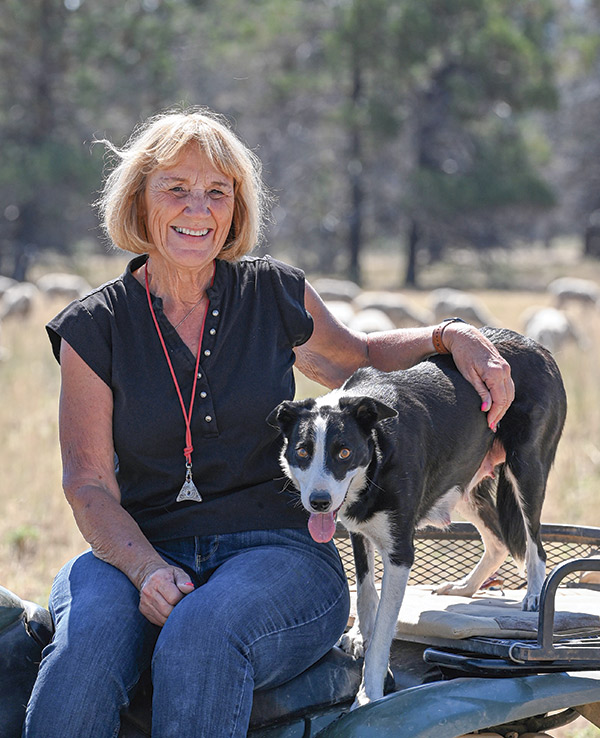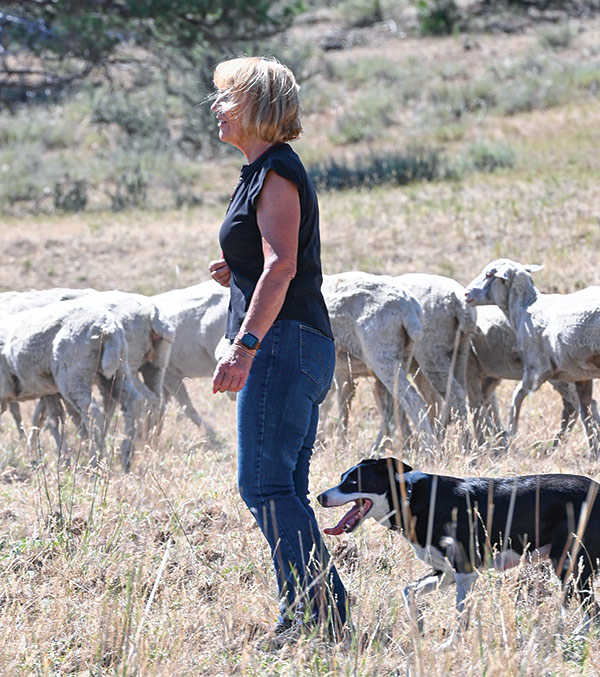It's a bountiful life: From pups to ranch partners

November/December 2023 California Bountiful magazine

Trainer helps farmers and ranchers teach their border collies to herd
Interview by Linda DuBois
Photos by Chelsea Shearer
A herding dog can be an invaluable asset for dairy farmers or ranchers trying to gather and steer cattle, sheep or goats in the right direction. But for these canines to be most helpful, they need to be properly trained.
That’s where people like Geri Byrne come in. She runs the Border Collie Training Center in Tulelake, which gives farmers and ranchers the tools they need to turn their playful pooches into working dogs.
Several times a year, she hosts sheepdog trials, where dogs and their owners can practice their skills, and clinics that teach dog owners how to train their dogs to herd. She also produces training videos.
When not focusing on her dog business, she stays busy serving on the Modoc County Board of Supervisors, a role she’s held since 2010.
What drew you to the border collie training business?
Well, I got my very first border collie as a student at Cal Poly (San Luis Obispo). My mom and dad had sheep and so they used it on their ranch. Then, when I got married and moved to my late husband’s cattle ranch, we used dogs there. I had friends who came out and helped with their dogs and I noticed their dogs were actually trained, unlike ours that weren’t so trained (laughing). And I thought, wow, their dogs are a lot more helpful.
So, I started learning to train my own dogs and had them participate in the sheepdog trials and then I just sort of got hooked on it all.
What makes a good herding dog?
Heart is really important—they have to have the heart for the job. They need biddability, so they’ll listen to what you have to say. You need good breeding to start with, which gives you a dog with good herding instincts. It’s a lot easier to train them and to work with them. Otherwise, you’re just spinning your wheels.
There are a lot of herding breeds that’ll work, but they have different natural instincts and purposes. For instance, the Australian cattle dog will naturally get behind and push cattle, whereas border collies are natural gatherers, and they’ll want to bring large groups to you.
Can you summarize the training process?
You start with their natural instincts and develop on them. So, you’ll start border collies in a round pen and the dog will bring the sheep to you, and as they learn to do that calmly, then you start giving them basic commands, like “lie down” and “walk up” (which means walk toward the livestock). For left and right, we use “come by” for clockwise and “away” for counterclockwise around the stock. You also want them to stay the proper distance from the livestock. At first, they’re going to want to be in too tight and too fast, but you want them to get a little farther away, so they have better control.
After you teach them voice commands, you put a whistle to it because a lot of times you’re working them a long distance from you and the whistle just carries better than your voice. So, they have whistles for “lie down,” “walk up” and all the rest and then variations of those whistles will be to do those faster or slower or wider or tighter.

Are the sheepdog trials just for fun or do they have a practical purpose?
They’re definitely practical. Sheepdog trials started over in the U.K. to mimic and test real-world work. They’re designed to replicate the practical parts of work on a farm or ranch.
So, the first thing you do is send your dog out 300 to 600 yards and they bring the sheep to you. Then you drive them through sets of gates and then you put them in a small pen and have them separate, say, two sheep from a group of about four. That you would use if you were out in the field and wanted to take a lamb away from the others or if you had something you needed the doctor to see or if you wanted to get your rams out.
The trials are also a good way to see how a dog compares to other dogs because you may think your dog is trained and then you take it somewhere like that and you go, “Oh, better go back to the drawing board.”
What are the training clinics like?
One of our most recent was with a trainer from England. It was four days and we had about a dozen people at a time with their dogs. Everybody takes turns. He gives talks and explains his theories of training and then he works with each person and dog twice a day, for about 10 or 15 minutes each. He gives them instructions on how to do it so that they’re actually doing it themselves instead of watching him do it, then they retain that better when they go home and try to do it themselves.
Do you train dogs for yourself?
Yes, I use my dogs for actual work on sheep. I used to own sheep, but now I borrow sheep. I have 220 head of sheep right now. I’m grazing them for the person who owns them, and then I get to train my dogs on them and hold all these events.
How old are puppies when you first start training them?
At about 6 to 8 months, you’ll start exposing them to some dog-broke sheep in a controlled environment to see what their instinct is and see when they’re ready. Usually, it’s closer to a year old before you’re really doing any serious training on them.
What value do herding dogs bring to ranchers and dairy farmers?
Lots. They can replace two or three people, easily, and unlike people, they never quit on you. They can go places quicker than you can get there and the livestock will move better for a dog than they will a person, even when on horseback or a quad or whatever. If a dog’s a proper distance and working them properly, it can move them better.
I lock up my 200-some-odd sheep at night just because of predators. If I go out to gather them up without a dog, it’s really hard. They just go, “Yeah, yeah. We’re still grazing,” but the dog can make them move.

